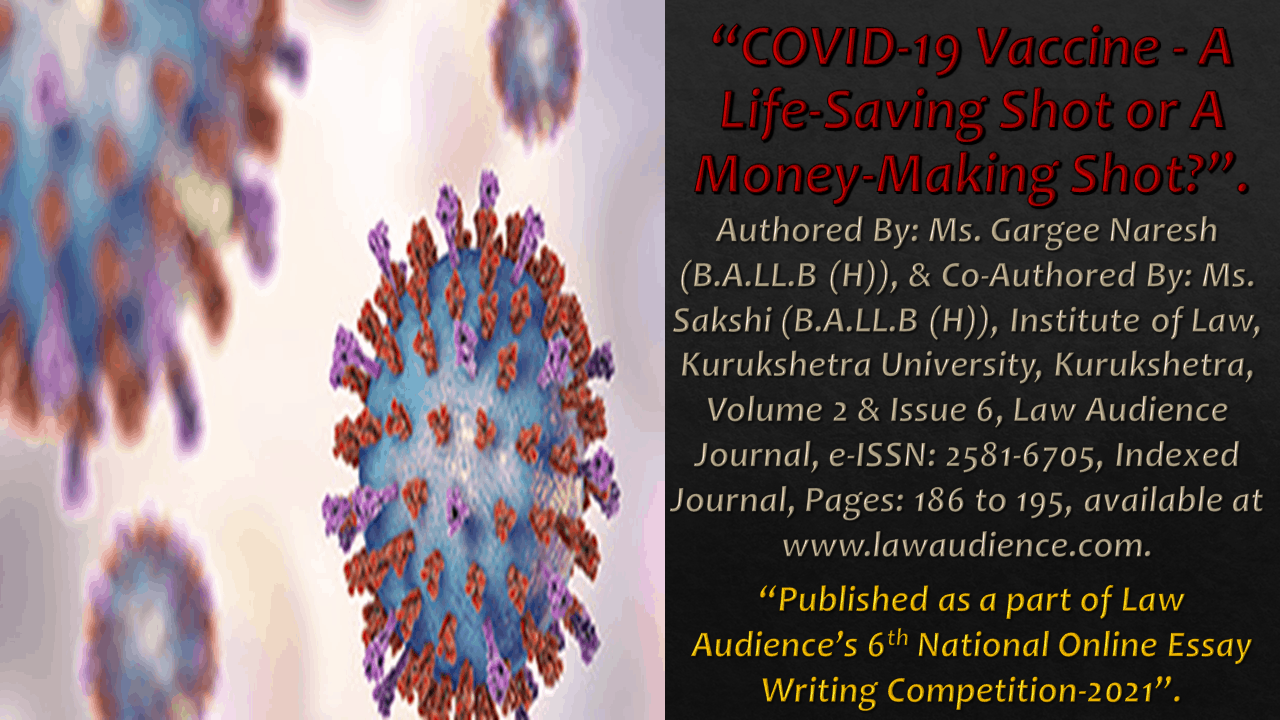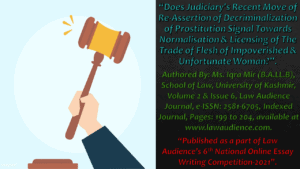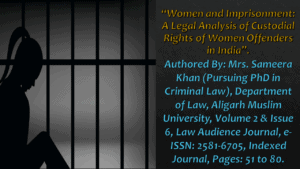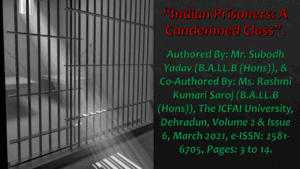Click here to download the full paper (PDF)
Authored By: Ms. Gargee Naresh (B.A.LL.B (H)), & Co-Authored By: Ms. Sakshi (B.A.LL.B (H)), Institute of Law, Kurukshetra University, Kurukshetra,
Click here for Copyright Policy.
I. INTRODUCTION:
As COVID-19 hits India more severely with its second wave, the only possible way out for India to fight this lethal virus, is ‘Vaccination’. But recently this life-saving shot has been caught up in the crosshairs of controversies. First due to the shortage of vaccines, as per the statistics, only 11.53% of the total Indian population is vaccinated till now[1]. The problem is more complex than the claims made by the government and various other organisations. To inoculate a population of seven billion, the world needs to produce about fourteen billion of vaccines and at the current pace; it would take several years to reach that volume of production. The only potent tool to deal with the ferocity of COVID-19 is ‘mass production’, and for that very purpose a significant number of vaccine production centres will have to be established. The mass production of every single unit of COVID-19 vaccine is based on various patents to which different companies claim holdings, or for the same those companies have made an application and those companies by doing so are abiding by the TRIPS agreement.
The pivotal information about the vaccine, as what is generally believed is not the ‘formula’ but, is the detailed knowledge of how a vaccine is actually produced[2]. Due to the dearth of vaccines, the situation has become woeful and this can only be put to an end if, the vaccine manufacturers issue more and more licenses, equip improved productions facilities and train an efficient faculty, because apportioning scientific and technical knowledge about the vaccine means winning the battle against this deadly virus. This fresh yet familiar issue is not only causing harm beyond measures in the sectors of health, science, technology and economy but is also a struggle against outdated ideas and pre-established private interests. The World Health Organisation has been repeatedly warning the world about the various stages of coronavirus and now that India has been hit by the second wave, the chances of third-wave striking are now favourably high. India being an underdeveloped country with a large population will not able to protect its countrymen unless vaccines are available in abundance, therefore India is strongly vocal regarding wavering of patents on vaccines. Also, it is not only about just one nation, there are forty-six, other developing nations as well, who might encounter the similar condition like India someday if no steps are taken at the earliest. Last year, in the month of October, India and South Africa moved a joint proposal at the WTO, seeking a temporary waiver of IP rights on COVID-19 vaccines and drugs. Both the countries argued that the production of vaccines needs to be sealed up to meet demand, WTO should recommend ‘a waiver from the implementation, application, and enforcement of certain provisions of TRIPS agreement for prevention, contamination and treatment of COVID-19.[3]
II. WHAT ARE PATENTS?
The patent is an intellectual property right. It is a ratified document granted by the government. The patent gives an investor exclusive right of producing and selling and also, to use that invention for a specific number of years[4]. ‘A patent for an invention is the grant of a property right to the inventor, issued by the United States Patent and Trademark Office.’[5] ‘A patent is a legal right granted by U.K. Intellectual Property Office for a new invention. It allows the owner of patent (the patentee) to take legal actions against others who use his inventions without his permissions.’[6] Under TRIPS the term ‘patent’ is not specifically defined in the TRIPS Agreement. A patent is the title given to the IPR that is granted to safeguard new inventions. A patent, which is granted by the authorities in a specified jurisdiction, gives its owner a privileged right to prohibit others from manipulating the patented invention in that jurisdiction for a limited period of time without his or her authorization, subject to a number of exceptions[7]. Under Indian Patents Act, 1970, Section 2(m) says ‘Patent means a patent for any invention granted under this act.’ Patent system is a contract between the inventor of the authority whereby the inventor gets exclusive rights for a period of 20 years in return for disclosing full details of invention’[8].
II.I A BRIEF HISTORY:
Patent originated first in the 15th century in the city of Venice, where the Republic of Venice held that ‘new inventions had to be communicated to the Republic in order to obtain a right to prevent others from practicing it. Then the first of numerous international treaties was Paris Convention to protect intellectual properties across the whole world. It was ratified on 20th March 1883. Initially the convention had 20 nations as its members but today it is followed by all the nations of the world. India became a member of the Paris convention in 1999[9].
III. WHAT IS THE TRIPS AGREEMENT?
This treaty acts as a model for most of the developing countries in twentieth century. The Trade Related Aspects of Intellectual Property Rights were introduced in 1994 and has more than 120 countries as its members currently. TRIPS have improved legal productions for patents worldwide. Since, this treaty is an international legal agreement between all the member nations of the World Trade Organization (WTO). Therefore, all the member nations of WTO have to abide by this agreement. The right of a government to issue a license to make use of a patent during the patent term without the patent holder’s consent is regulated by Article 31 of the TRIPS Agreement[10].
IV. WHY IS PATENT PROTECTION IMPORTANT TO DRUG MAKERS?
Medicines are incredibly expensive to develop as most of the experimental drugs fail at some point during the stages of laboratory, animal or human trials. As a consequence of such failures the money spent on bringing a drug from discovery to regular use roughly costs around one billion or more than that and patent rewards innovation by preventing other competitors from simply copying a company’s discovery and launching a rival product, all because it usually takes more than a decade to get an approval for a drug. But drugmakers usually find ways to improve their products or widen their use[11].
V. PATENT AND PANDEMIC:
Under the current situation, vaccines are patented and as a result their formulas are locked away. Big pharmaceutical companies laid out in developed countries are unwilling to publicly share knowledge. So, a handful of companies are doing all the heavy lifting and are producing vaccines in a limited capacity. If these developed countries give away their vaccine formulas, then vaccines would become globally common and every pharmaceutical company in the world capable of producing a vaccine would then be able to produce, curtailing the current shortage of vaccine around the world. To support the idea of relaxing the patent on vaccines, the precedent for the same should not be ignored. In 2001, the WTO waived patent on drugs for LDC’s (least developed countries). In 2015, the same waiver was extended for another 17 years. This waiver emphasised that patents are important but they are not absolute[12].
VI. HOW TO LIFT PATENT PROTECTION FROM VACCINES?
One possible option can be compulsory licensing by the government. Vaccines are always patented by their makers. It is the job of the government to protect these patents. But in some exceptional cases such as an emergency, the government can itself override the patents[13].
VI.I LEGAL ASPECTS:
Under the Indian scenario, the concept of compulsory licensing is permitted under the Act of 1970. Section 92 and 100 of the Patents Act, were specifically cited in the court order. Section 92 is a specific provision that enables the central government to issue compulsory licences for the production of patented drugs in a public health emergency. Section 100 empowers it to use patented inventions for government purposes. The honourable Supreme Court has asked the government on a stricter note to waive off the patent to which government of India has replied via a forty pages long affidavit and has tried to answer the questions put forth by the apex court, the government of India in that affidavit has said that they are engaging at diplomatic level to procure vaccines and medicines[14].
Countries are free to issue compulsory licenses during emergencies. There is only one caution. The patent owner must be suitably compensated in order to avoid any backlash from Geneva. Even the apex court of India is also advising the centre government to consider this option. The waiver controversy has emerged again nearly after two decades of, end of a long battle in the multilateral trading system over access to HIV/AIDS drugs. Having spent billions of dollars on developing the drugs, the patent holders resist on lowering their prices, the credibility of the companies, the countries that supported them and the WTO itself were all damaged by the extended controversy on, whether patent rights should take precedence over providing affordable medicines for people affected by this lethal virus[15].
Article 8 of the WTO Agreement on the Trade‐Related Aspects of Intellectual Property Rights (the TRIPS Agreement) provides that WTO members “may, in formulating or amending their laws and regulations, adopt measures necessary to protect public health provided that such measures are consistent with the provisions of this Agreement.” In similar vein, Article 7 of the TRIPS Agreement provides that the “protection and enforcement of intellectual property rights” shall be “in a manner conducive to social and economic welfare.” It can be maintained that these two WTO IP rules are significantly capacious to include any reasonable health measures that a WTO member may take during a health emergency, such as a pandemic. Yet there was a doubt among the members during the HIV/AIDS crisis about the precise reach of these provisions[16].
Article IX.3 of the Marrakesh Agreement establishing the WTO (or the WTO Agreement) provides that in “exceptional circumstances”, the Ministerial Conference may waive an obligation imposed on a WTO member country by the WTO Agreement or any other multilateral trade agreement. The same article provides that such a waiver be supported by three-quarters of the members, Article IX.4 of the WTO Agreement states that the Ministerial Conference, while granting the waiver shall state the “exceptional circumstances” justifying the decision and the terms and conditions that shall govern the working of the waiver. The Covid-19 global pandemic—the worst global health crisis in the last 100 years that has devastated lives all over the world and caused unprecedented economic and social destitution—undoubtedly constitutes an “exceptional circumstance” as defined under Articles IX.3 and IX.4 of the WTO Agreement[17].
VI.II HUMANITARIAN RIGHTS:
The most important international instrument on socio- economic rights is the International Covenant of Economic, Social and Cultural Rights (ICESCR) of 1966, which has been ratified by 130 states. The Covenant recognised one of the substantive rights, which is ‘The Right of everyone to enjoyment of highest attainable standards of physical and mental health[18]. Particularly, parties are obliged to take steps necessary for ‘Prevention, treatment and control of epidemic, endemic, occupational and other diseases and the creation of conditions which would assume to all medical services and medical attention in event of sickness[19].
VII. COUNTRIES IN FAVOUR OR AGAINST:
In this present scenario, The US, The European Union, Canada and The UK are among the prominent holdouts to the proposals made by India and South Africa. After the US made a U-turn, European commission’s President Ursula Von Der Leyen said that the EU is ready to discuss how the US proposal for a waiver for vaccines could help achieve the objective of addressing the COVID-19 crisis in a pragmatic manner. Till this week the US, The European Union, Canada and The UK were among the prominent holdouts to the proposal made last year by India and South Africa for releasing the norms of the WTO agreement on TRIPS for COVID-19 vaccine[20].
A member from European Union explained that “There is no evidence that intellectual property rights are a genuine obstacle for handiness of COVID-19 related medicines and technologies”. The pharmaceutical companies in the global vaccines chase have been quick to express their opposition to the proposed waiver of IP rights for the pandemic’s duration[21]. They have warned that allowing these COVID-19 vaccines to be copied through resort to compulsory licensing ‘would sabotage innovation and raise the risk of unsafe viruses. Also, Director General of WTO Nagozi Okonjo- Iweala also pushed the member nations to reach some agreement by July and deliver a final outcome on the Intellectual property waivers for COVID-19 vaccines at next ministerial meeting in December[22].
As per the United States Trade Representatives, this is a global health crisis and the extraordinary circumstances of COVID-19 pandemic calls for extraordinary measures. They also put forth a strategy that may accelerate the inoculation drives across the world especially in poor countries amid the raging coronavirus pandemic. And they also agreed to support the joint proposal at WTO, to waive Intellectual property protections for COVID-19 vaccines. This proposal is now supported by above 100 countries while The European Union, The UK, Switzerland, Japan and Australia continue to oppose it.
This proposal of relaxing the patents on vaccines seeks to avoid any hindrance to the timely access, of affordable medical products including vaccines and medicines and to speed up the research development, manufacturing process and supply of essential medical products. The mechanics of patent waivers is already explained and it is argued that waivers alone are the wrong policy tool in the context of the COVID-19 pandemic[23].
Many agree with the supporters of waiver with their ultimate goal of scaling up the manufacturing of COVID-19 vaccines and then distributing those according to more equitable models than the ones adopted till now. However, this also raises a serious doubt that the particular types of goods at stake here can be easily copied and manufactured in considerably larger quantities simply through a waiver of intellectual property rights.
While requesting for broad waiver of IP rights to COVID-19 vaccines, India and South Africa mentioned that “many countries especially least developed countries may face institutional and legal difficulties when using flexibilities available” under the existing WTO rules. They also made a pertinent point that a “special concern for countries with inadequate or no manufacturing capacity” is that the 2017 amendment which permits these countries to produce generic medicines under compulsory license to export all the medicines to least developed countries that lack their own manufacturing capabilities will lead to a “cumbersome and lengthy process” For the shorter duration, relaxing private IP rights may boost up the distribution of goods and services—where the novel knowledge that went into making them already exists.
But in the longer duration, relaxing private IP rights would wipe out the incentives that inspire innovation, thus discouraging the discovery and development of knowledge for new goods and services that the world needs[24]. This widespread dismissal of the link between private IP rights and innovation is perhaps best reflected in the fact that although the United Nations Sustainable Development Goals for 2030 aspire to “foster innovation,” they make no mention of IP rights.
VIII. CONCLUSION:
To recapitulate, we can say that, lifting the patents protection from over the companies manufacturing COVID-19 vaccine will boost up the production in developing countries where the situation is scathing. It will help to meet the higher demand, due to the vast population.
But as we flip the coin, this phenomenon has a despairing effect. The suspension is a simple but not apt solution to such a complex problem. It will not increase production but will jeopardise future innovations. Further, it will weaken already our strained supply chains and encourage the proliferation of counterfeit vaccines.
Footnotes:
[1] Gaurav Chaudhary, COVID-19 | US support for waiving vaccine patents, India’s role and other questions answered, Money control(MAY 06, 2021 / 11:28 AM),https://www.moneycontrol.com/news/india/covid-19-us-support-for-waiving-vaccine-patents-indias-role-and-other-questions-answered-6860361.html/amp.
[2] Opinion: COVID vaccine patents are not the issue, from DW (May 5,2021), https://www.dw.com/en/opinion-covid-vaccine-patents-are-not-the-issue/a-57467916.
[3] Bindu Shajan Perappadan, India, S. Africa move WTO on COVID-19 prevention, treatment, The Hindu (October3,2020,06:50pm),https://www.thehindu.com/news/national/india-s-africa-move-wto-on-covid-19-prevention-treatment/article32760770.ece.
[4] Sneha Kolluru, Concept and historical view of the Patents, lawtimesjournal,(July 4, 2020),https://lawtimesjournal.in/concept-and-historical-view-of-the-patents/#:~:text=The%20first%20patent%20was%20enacted,were%20made%20over%20the%20years.&text=The%20Indian%20Patents%20Act%2C1970,and%20declaration%20of%20the%20invention.
[5] Alexandria ,General information concerning patents, USPTO,(April 22,2021,09:09 am),https://www.uspto.gov/patents/basics#:~:text=A%20patent%20for%20an%20invention,States%20Patent%20and%20Trademark%20Office.&text=U.S.%20patent%20grants%20are%20effective,U.S.%20territories%2C%20and%20U.S.%20possessions.
[6] Patents – The Basics, Mewburn Ellis (February 8, 2019),https://www.mewburn.com/law-practice-library/uk-patents-the-basics#:~:text=A%20patent%20is%20a%20legal,his%20invention%20without%20his%20permission.
[7] Hemant Singh, What is Trade Related Aspects of Intellectual Property Rights (TRIPS)?, Jagran josh(Nov 30, 2015 05:30pm),’https://www.jagranjosh.com/general-knowledge/trade-related-aspects-of-intellectual-property-rights-trips-1448884301-1.
[8] The Patents Act, 1970, No.15 of 2005, Act of parliament, 1970 (India).
[9] Sneha Kolluru, Concept and historical view of the Patents, lawtimesjournal, (July 4, 2020), https://lawtimesjournal.in/concept-and-historical-view-of-the-patents/#:~:text=The%20first%20patent%20was%20enacted,were%20made%20over%20the%20years.&text=The%20Indian%20Patents%20Act%2C1970,and%20declaration%20of%20the%20invention.
[10] Overview: the TRIPS Agreement, World Trade Organization, https://www.wto.org/english/tratop_e/trips_e/intel2_e.htm.
[11] FP staff, Vaccine patent waiver: What are IP rights, and which nations stand for and against US proposal, First post(May 07, 2021 09:34 pm),https://www.firstpost.com/world/vaccine-patent-waiver-what-are-ip-rights-and-which-nations-stand-for-and-against-us-proposal-9601781.html.
[12] Vivek Dehejia, A WTO waiver on patents won’t help us against covid, Mint(April 28,2021),https://www.livemint.com/opinion/online-views/a-wto-waiver-on-patents-won-t-help-us-against-covid/amp-11619625719625.html.
[13] FP staff, Vaccine patent waiver: What are IP rights, and which nations stand for and against US proposal, First post(May 07, 2021 09:34 pm),https://www.firstpost.com/world/vaccine-patent-waiver-what-are-ip-rights-and-which-nations-stand-for-and-against-us-proposal-9601781.html.
[14] Bhadra Sinha, Invoking Patents Act for production of Covid vaccines, drugs can have consequences: Govt to SC, The print(May 10, 2021 8:04 pm),https://theprint.in/judiciary/invoking-patents-act-for-production-of-covid-vaccines-drugs-can-have-consequences-govt-to-sc/655863/.
[15] James Bacchus, An Unnecessary Proposal: A WTO Waiver of Intellectual Property Rights for COVID-19 Vaccines, Cato Institute (December 16,2020)https://www.cato.org/free-trade-bulletin/unnecessary-proposal-wto-waiver-intellectual-property-rights-covid-19-vaccines.
[16] James Bacchus, An Unnecessary Proposal: A WTO Waiver of Intellectual Property Rights for COVID-19 Vaccines, Cato Institute (December 16,2020)https://www.cato.org/free-trade-bulletin/unnecessary-proposal-wto-waiver-intellectual-property-rights-covid-19-vaccines.
[17] Prabhash Ranjan, The Case for Waiving Intellectual Property Protection for Covid-19 Vaccines, Observer Research Foundation (April 6,2021),https://www-orfonline-org.cdn.ampproject.org/v/s/www.orfonline.org/research/the-case-for-waiving-intellectual-property-protection-for-covid-19-vaccines/?amp_js_v=a6&_gsa=1&usqp=mq331AQFUAKwASA%3D#referrer=https%3A%2F%2Fwww.google.com&_tf=From%20%251%24s&share=https%3A%2F%2Fwww.orfonline.org%2Fresearch%2Fthe-case-for-waiving-intellectual-property-protection-for-covid-19-vaccines%2F.
[18] ICESCR, Art.(12)(c).
[19] ICESCR, Art. (12) (d).
[20] Ana Santos Rutschman and Julia Barnesweise, The COVID-19 Vaccine Patent Waiver: The Wrong Tool for the Right Goal, Bill of health (May05,2021),https://blog.petrieflom.law.harvard.edu/2021/05/05/covid-vaccine-patent-waiver/.
[21] Syed Akbaruddin, A new chapter for the TRIPS waiver proposal, Hindustan times (MAY 10, 2021 06:32 PM),https://www.hindustantimes.com/opinion/a-new-chapter-for-the-trips-waiver-proposal-101620651498686.html.
[22] Vikas Dhoot, WTO Chief Targets waivers for Covid Vaccines in Dec., The Hindu, May 13,2021 at page no. 14.
[23] Silvia Amaro, EU leaders raise doubts over U.S. plan to waive Covid vaccine patents, CNBC (MAY 10, 2021, 05:35 AM ),https://www.cnbc.com/2021/05/10/covid-vaccine-patents-eu-doubtful-of-us-plan-to-waive-ip-rights.html.
[24] Farasat Bokaro,Price to production: Pros and cons of achieving Covid vaccine patent waiver, Business Standard,(May 10,2021,11:22),https://wap.business-standard.com/article/current-affairs/pros-and-cons-of-vaccine-patent-waiver-backed-by-us-121051000268_1.html.
Cite this article as:
Ms. Gargee Naresh & Ms. Sakshi, COVID-19 Vaccine – A Life-Saving Shot or A Money-Making Shot?, Vol.2 & Issue 6, Law Audience Journal, Pages 186 to 195 (28th June 2021), available at https://www.lawaudience.com/covid-19-vaccine-a-life-saving-shot-or-a-money-making-shot/.



